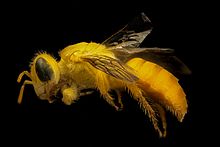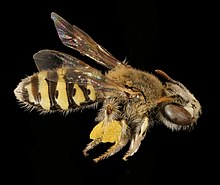fr
noms dans le fil d’Ariane


The bee subfamily Panurginae is a diverse lineage of 33 genera in 7 tribes. They are particularly diverse in the New World, though scarce in the tropics, and in the Old World they can be found primarily in the Palaearctic and Africa, but absent from Australia and tropical Asia. They tend to be associated with xeric or sandy habitats.
The "facial foveae" of Panurgines are not broad, velvety depressions as in Andreninae, but reduced to grooves or pits at the upper margin of the eyes. The apex of the marginal cell of the wing is truncate, and the trochanteral scopa is reduced. Panurgines also frequently have yellow markings in locations other than on the face, a feature not seen in any other subfamilies of Andrenidae.
Most members of this subfamily are oligolectic, with highly specialized floral associations, especially in desert species.

 Calliopsis sp., female
Calliopsis sp., female The bee subfamily Panurginae is a diverse lineage of 33 genera in 7 tribes. They are particularly diverse in the New World, though scarce in the tropics, and in the Old World they can be found primarily in the Palaearctic and Africa, but absent from Australia and tropical Asia. They tend to be associated with xeric or sandy habitats.
The "facial foveae" of Panurgines are not broad, velvety depressions as in Andreninae, but reduced to grooves or pits at the upper margin of the eyes. The apex of the marginal cell of the wing is truncate, and the trochanteral scopa is reduced. Panurgines also frequently have yellow markings in locations other than on the face, a feature not seen in any other subfamilies of Andrenidae.
Most members of this subfamily are oligolectic, with highly specialized floral associations, especially in desert species.
Panurginae es una subfamilia de abejas de la familia Andrenidae. Contiene alrededor de 1,400 especies en 35 géneros en 7 tribus, la gran mayoría en el género Perdita.[1]
Alcanzan su mayor diversidad en el Nuevo Mundo. Están ausentes en Australia y en Asia tropical. Prefieren hábitats áridos y arenosos.
La mayoría son oligolécticos, con asociaciones florales altamente especializadas, especialmente en zonas desérticas. La mayoría son de una sola generación anual y los adultos tienen una corta vida.
Panurginae es una subfamilia de abejas de la familia Andrenidae. Contiene alrededor de 1,400 especies en 35 géneros en 7 tribus, la gran mayoría en el género Perdita.
Alcanzan su mayor diversidad en el Nuevo Mundo. Están ausentes en Australia y en Asia tropical. Prefieren hábitats áridos y arenosos.
La mayoría son oligolécticos, con asociaciones florales altamente especializadas, especialmente en zonas desérticas. La mayoría son de una sola generación anual y los adultos tienen una corta vida.